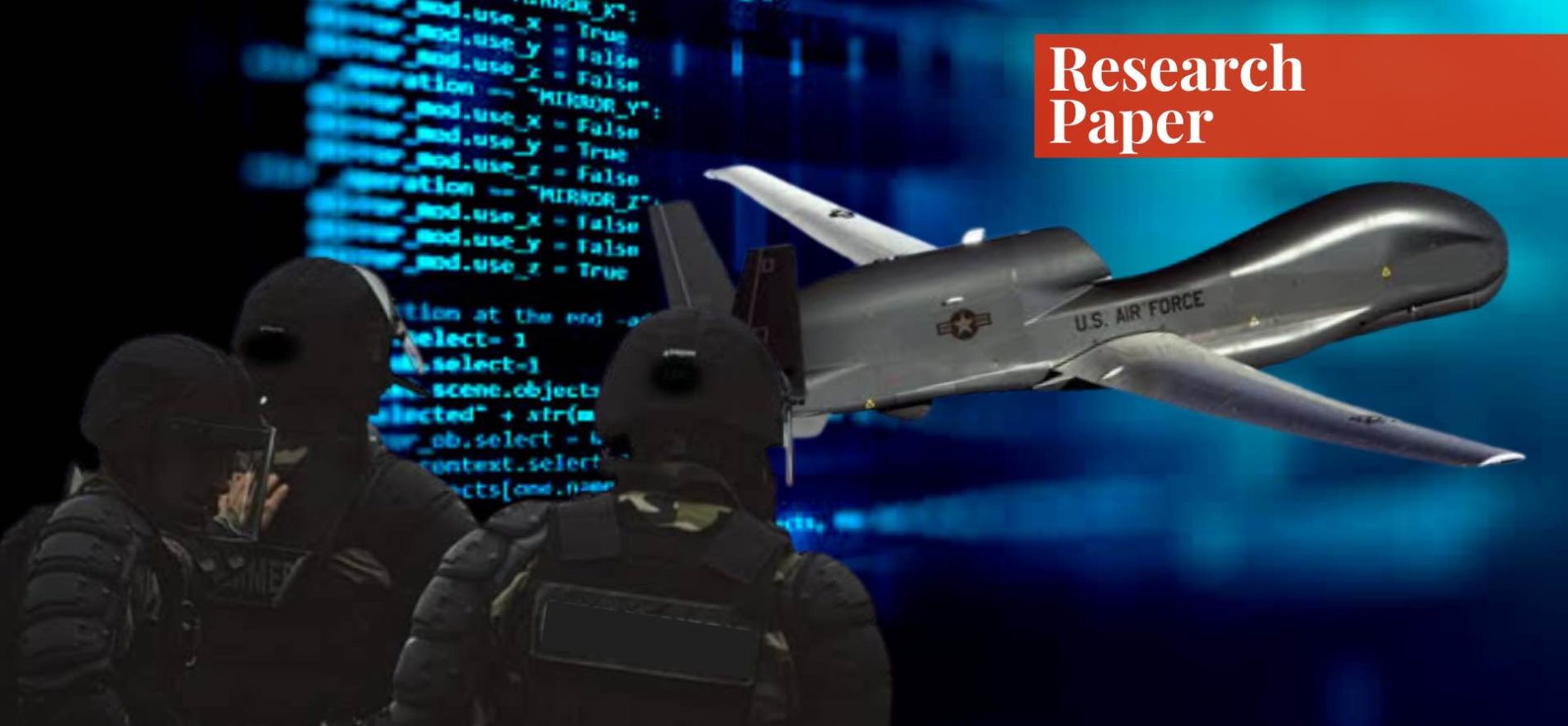Ahsan Riaz is currently pursuing his bachelor's in international relations from the National University of Modern Languages (NUML), Islamabad.
Artificial Intelligence
Artificial Intelligence (AI) is a field of computer science and information technology that deals with creating and developing algorithms that can perform tasks much faster than humans can. It’s widely used in today’s technology, such as search engines and Google, to improve human performance. The rise of AI is not a new phenomenon. Artificial intelligence has been around for a long time and is now even influencing the future of war. Computer science even predates humanity. But the rapid progress we’ve seen in the field is unprecedented.
Before getting into detail about AI, it is important to know what intelligence is. Intelligence is “a very general mental capability, that among other things involves the ability to reason, plan, solve problems, think complex plans, and learn quickly and from experience” (Gottfredson 1997, p. 13).
Despite its rapid rise, there is a lack of consensus on the definition of AI (artificial intelligence). However, it can be defined as “the science and engineering of making intelligent machines” (McCarthy, 1955). It emerged with the development of digital computers around the 1940s, nonetheless, a breakthrough in the field of artificial intelligence was introduced in 1956 at the Dartmouth Conference.
The rise of AI will impact our world more than you may think. After all, it’s already been used in several applications including financial services, business, and healthcare. Now, new military technologies are beginning to mimic the different activities of our brains and these artificial intelligence tools can be used to help. Artificial intelligence gives machines the ability to think in a limited way. Its major characteristics include pattern and speech recognition, data analysis, and decision making.
“Warfare is generally understood to be the controlled and systematic waging of armed conflict between sovereign nations or states, using military might and strategy, until one opponent is defeated on the field or sues for peace in the face of inevitable destruction and greater loss of human life” (Mark, 2009).
There are four major elements of warfare:
- Weaponry (guns, bullets, missiles, tanks, jets, drones, aircrafts, submarines, and nuclear arsenal)
- Fields of weaponry (land, airborne, naval, space, logistics, propaganda)
- Military doctrines—Anti-Access (A2)/Area Denial (AD), command, control, communications, computers, intelligence, surveillance, and reconnaissance (C4SIR)
- Battle (types of battles and wars)
Nature and Character of War
Before getting further into the conversation, it is important to understand the difference between the nature and character of warfare. Carl von Clausewitz in his book “On War” distinguishes between the two. He says that the nature of war describes what war is and the character explains how the war is fought. The nature of war is further elaborated as violent, detrimental, political, and consisting of opposing wills.
However, the character is expressed as the technology used, laws and ethics of the world, and methods of social, political, and militant organization. Clausewitz highlights how failing to understand the character of war leads to disaster. He explained how Prussian generals used old tactics against the Napoleonic army who modernized their tactics of war with time. Development of new tactics, weapons, and strategies need to be appreciated and accepted instead of sticking to the old ones. (Clausewitz, 1968)
With the passing of time and the evolution of humans and technological advancements, warfare has also seen an upgrade in its character. The evolution has seen many phases, from daggers/hammers in the Stone Age to swords to bows and arrows to catapults. History saw a great transition with the development of gunpowder in China in medieval times. Then led to the development of engines, and planes in modern times, then to the production of guns, machine guns, missiles, drones, and nuclear weapons.
Rise of AI and Autonomous Weapons
AI is changing the future of war by bringing autonomy to weaponry. There are three elements in this regard: perception, cognition, and action. The former two are the set of instructions and algorithms and the latter is the result. Autonomous weaponry can be described as a weapon system that requires no supervision or confirmation before executing its tasks.
According to Mark Gubrud, Ph.D., a member of the International Committee for Robot Arms Control, “Autonomous weapons are robotic systems that, once activated, can select and engage targets without further intervention by a human operator. Examples include drones or missiles that hunt for their targets, using their onboard sensors and computers. Based on a computer’s decision that an appropriate target has been located, that target will then be engaged” (Gubrud, 2014).
The most important aspects in military operations covered by artificial intelligence, as of now, are mainly surveillance, and facial recognition. Artificial intelligence in the military focuses on three main aspects:
- Cyber attacking software
- Data crunchers
- Autonomous machines
However, the level of autonomy can be seen in various degrees, from a low level of autonomy, say landmines, to semi-autonomous weapons such as fire and forget missiles, and finally to a high level of autonomy. For example, both the United States Navy and the Israeli army have weapons systems that can autonomously detect, track, and fire at incoming missiles, using programmed parameters.

Unmanned air vehicles (UAVs) are autonomous to the extent of navigation. They function according to the coordinates put into them, the rest is all programmed. The weapon systems in production now, with high-end artificial intelligence and machine learning will have a much higher level of autonomy, such as killer robots, possessing the ability to move freely, detect targets on their own, and make the decision to fire and kill the target on their own will.
They will be able to perform complex actions on their own, and won’t be requiring human assistance. In a given war in the future, they will also be fighting on battlegrounds either with human soldiers or without. It is believed to be a much safer way of war (“Killer Robots,” n.d.). However, critics say that computer programs can malfunction which might result in friendly casualties.
“Losing Humanity,” a report released by Human Rights Watch in November 2012. The report argues that technical limitations mean robots could not reliably distinguish civilians from combatants, particularly in irregular warfare, and could not fulfill the requirement to judge proportionality (Losing Humanity, 2012).
AI and Aircrafts
Fully autonomous weaponry has to go through economic barriers. US Air Force’s Lockheed Martin F-22A, the most stealthy and lethal jet has a cost of approximately a hefty amount of $125 million (O’Hanlon, 2021). With the development and rise of AI, it can be said that AI is going to beat humans in any future war. An AI algorithm was put head to head in 5 stimulated dogfights with a US Air Force F-16 pilot, and the machine emerged victorious every time (Pickrell, 2020).
Keeping in view, the high risk and vulnerability of data links in a battleground, AI has helped come up with a more survivable option, Global Hawk—a high-end intelligence-gathering unarmed drone. Human vulnerability has been reduced due to the machine, and it is considered to be more reliable and survivable.

The UAV is used to relay intelligence, surveillance, and reconnaissance data to fighting units on the ground. Global Hawk has a total of more than 320,000 flight hours with missions flown in support of military operations in Iraq, Afghanistan, North Africa, and the greater Asia-Pacific region (Global Hawk, n.d.).
To support and bodyguard air combatants, Australian Airforce Researchers accompanied by Boeing have come up with an unmanned aircraft, the Loyal Wingman. The aircraft is considered to be a game-changer in the field of autonomous systems. It is incorporated with artificial intelligence and designed to fly alongside manned combat aircraft providing equal surveillance, and defense, and helping take down aircrafts (Tupas, 2021).
The AI Race
Policymakers and military institutions all around the world are facing competitive pressure to expand the use of military applications of AI. The United States, the People’s Republic of China, and Russia are the most important in this regard. On part of the US, experimentation with autonomous boats which can detect and track submarines from thousands of miles is being conducted. Similarly, China is exploring swarm intelligence while Russia is working on underwater drones (Abbas, 2022).

Several heads of states and tech giants express simultaneous optimism and despair concerning the rise of AI in modern times. Putin professed his views about AI as, “the future, not only for Russia but for all humankind. It comes with colossal opportunities, but also threats that are difficult to predict. Whoever becomes the leader in this sphere will become the ruler of the world” (Putin as cited in Vincent, 2017).
With the rise of AI, we have entered the dawn of a new arms race in this evolving world. The development and evolution of killer robots have been described as a potentially seismic and vulnerable event in warfare akin to the invention of gunpowder and nuclear bombs, putting us in the third revolution of warfare.
Matt Mahmoudi, an AI researcher at Amnesty International, says in an interview that, “states are in competition with each other around autonomous weapon systems.” Artificial intelligence is on its way to becoming a key weapon in the arsenal of 21st-century warfare (Mahmoudi, 2022).
Pros and Cons
A better understanding of the evolution and rise of AI in means of speed, lethality, and accuracy can be made by reference to the Go game, arguably the most complex game in the history of mankind. It is considered to be one of the oldest games played by humans. However in 2016, artificial intelligence, AlphaGo took over and defeated the 18 times Go world champion, Lee Sedol, with a victory of 4-1.
It ran through millions of games and learned the techniques used and even made up new ones that no one has ever seen. Soon after, it was witnessed that AlphaGo zero defeated 100 out of 100 games to AlphaGo, its predecessor, with just learning of 40 days. It can be seen how efficient artificial intelligence is becoming that it was able to beat humans at their own game and the new champion was defeated by its successor, AI defeating AI is putting humans out of the picture right there and then (Borowiec, 2016).
Military application of artificial intelligence can help change the nature of warfare. (Maxwell, 2020) AI in warfare can have many advantages as well as limitations. AI would be better at sensing threats, it would lessen the human workload. It would help in engaging strategy building without the bias of personal will, emotions, and selfishness.
Artificial intelligence, with its algorithms, will be able to increase the pace of wars, as building strategies and tactics would be easy. It would also increase the speed of data analysis. The rise of AI ascertains that there will be no room for human errors and tasks would be carried out accurately. As for the limitations, despite the evolving nature of AI, it can never have the instincts as humans. It can easily be fooled or hacked and can be used against ourselves.
Another limitation is their inability to multitask, they’ll perform what they’ve been programmed for. After coming up with a definition, humans possess the capability to express their thought processing, which leads to the decision. On the contrary, humans can comprehend very little about how AI made the decision.
Conclusion
The rise of AI and the changing nature of warfare could have a profound effect on the way conflicts are fought. Artificial intelligence is already changing the future of war. The extent of this autonomous weaponry cannot be measured with certainty at present, what is obvious is that it will change the future of war in every dimension. It can identify targets, predict the outcome of a conflict and even predict the future of entire populations. The military has long sought to harness the power of artificial intelligence to improve the behavior of soldiers.
It can be seen and learned that the lust for power among the states of this world has only resulted in being one step ahead of their adversaries. Whether it be in the fields of technological advancements or the development of modern weaponry, the superpowers became and remained the same just because of the unparalleled military advancements and arsenal.
We are still living in the same world and the principle of history is not going to change but surely will repeat itself over time. Only this time, the results will be dismal and tragic. All the states are running towards incorporating their arsenal with as much AI, and autonomous weaponry, because that is the future. They all need to be prepared for what comes next and deal with it accordingly; obviously, you can’t fight a UAV with a catapult.
References
- Abbas, Z. (2022). AI usage and its scope in Pakistan. Paradigm Shift. https://www.paradigmshift.com.pk/ai-usage/
- Ahmad, K. (2019). Artificial Intelligence and the Changing Nature of Warfare. Stratagem, 1(2), 57-72. Retrieved from https://journal.cscr.pk/stratagem/index.php/stratagem/article/view/26
- Basit, A. & Baig, M.A (2021). Impact of new technologies on the nuclear deterrence strategy. Paradigm Shift. https://www.paradigmshift.com.pk/nuclear-deterrence-strategy-new-technologies/
- Borowiec, S. (2016, March 15). AlphaGo seals 4-1 victory over Go grandmaster Lee Sedol. The Guardian. https://www.theguardian.com/technology/2016/mar/15/googles-alphago-seals-4-1-victory-over-grandmaster-lee-sedol
- Clausewitz, C. v. (1968). On War. Penguin.
- Global Hawk. (n.d.). Northrop Grumman. https://www.northropgrumman.com/what-we-do/air/global-hawk/
- Gottfredson, L. S. (1997). Mainstream science on intelligence: An editorial with 52 signatories, history, and bibliography. Intelligence, 24, 13.
- Gubrud, M. (2014). Stopping Killer Robots. Bulletin of Atomic Scientists, 32-42. https://www.tandfonline.com/doi/abs/10.1177/0096340213516745
- Killer Robots. (n.d.). Human Rights Watch. https://www.hrw.org/topic/arms/killer-robots
- Losing Humanity. (2012). Human Rights Watch. Retrieved from: https://www.hrw.org/report/2012/11/19/losing-humanity/case-against-killer-robots
- Mahmoudi, M. (2022, April 22). Is artificial intelligence the future of warfare? (M. L. Hill, Interviewer).
- Mallick, P. K. (2019, January 18). Is Artificial Intelligence (AI) Changing the Nature of War?
- Mark, J. J. (2009, September 02). Warfare. Retrieved from World History: https://www.worldhistory.org/warfare/
- Maxwell, P. (2020, April 20). Artificial intelligence is the future of warfare. Modern War Institute at West Point.
- McCarthy, J. (2007, November 12). What is artificial intelligence?. Stanford. https://www-formal.stanford.edu/jmc/whatisai/whatisai.html
- O’Hanlon, M. (2021). The Plane Truth: Fewer F-22s Mean a Stronger National Defense. Brookings. https://www.brookings.edu/research/the-plane-truth-fewer-f-22s-mean-a-stronger-national-defense/
- Vincent, J. (2017, September 04). Putin says the nation that leads in AI ‘will be the ruler of the world. The Verge.https://www.theverge.com/2017/9/4/16251226/russia-ai-putin-rule-the-world
- Pandya, J. (2019, January 14). The Weaponization Of Artificial Intelligence. Forbes. https://www.forbes.com/sites/cognitiveworld/2019/01/14/the-weaponization-of-artificial-intelligence/?sh=35d803c83686
- Pickrell, R. (2020, August 22). A US Air Force F-16 pilot just battled AI in 5 simulated dogfights, and the machine emerged victorious every time. Business Insider. https://www.businessinsider.in/tech/news/a-us-air-force-f-16-pilot-just-battled-ai-in-5-simulated-dogfights-and-the-machine-emerged-victorious-every-time/articleshow/77684786.cms
- Tupas, N. (2021, November 29). The Loyal Wingman in a league of its own. Defence Connect.
If you want to submit your articles, research papers, and book reviews, please check the Submissions page.
The views and opinions expressed in this article/paper are the author’s own and do not necessarily reflect the editorial position of Paradigm Shift.


















